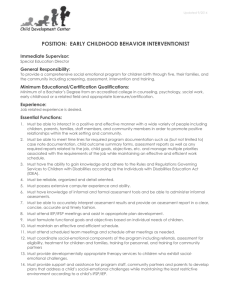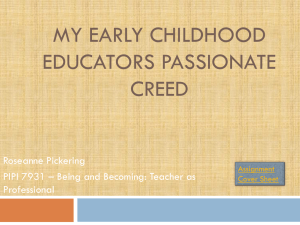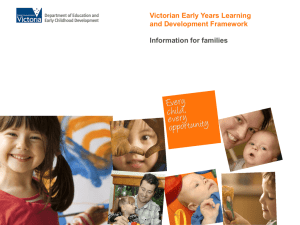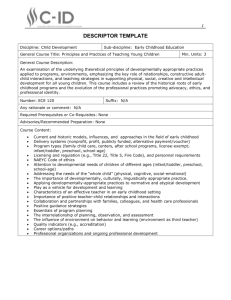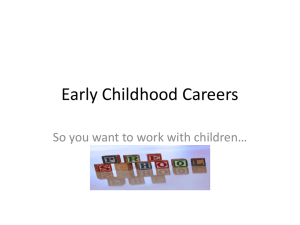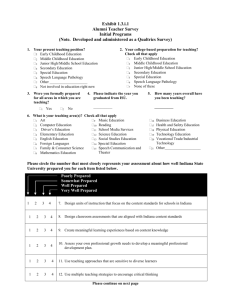Standards - Great Start to Quality
advertisement
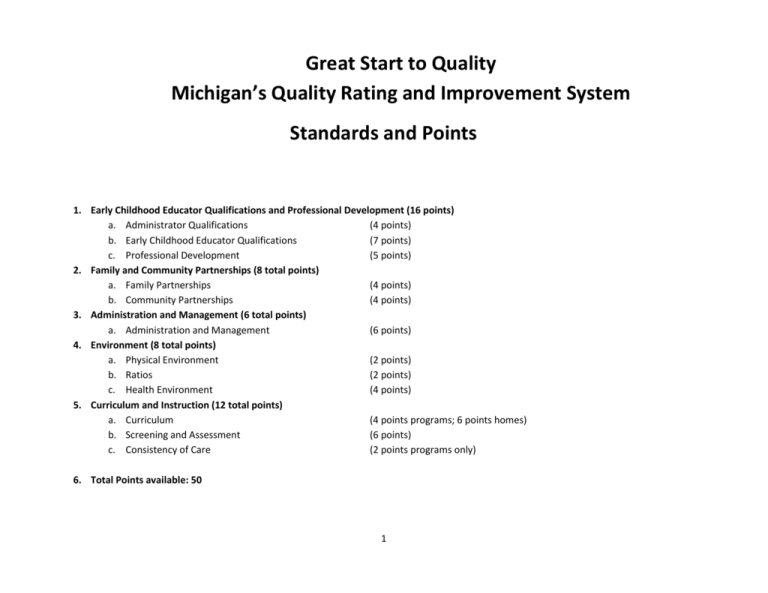
Great Start to Quality Michigan’s Quality Rating and Improvement System Standards and Points 1. Early Childhood Educator Qualifications and Professional Development (16 points) a. Administrator Qualifications (4 points) b. Early Childhood Educator Qualifications (7 points) c. Professional Development (5 points) 2. Family and Community Partnerships (8 total points) a. Family Partnerships (4 points) b. Community Partnerships (4 points) 3. Administration and Management (6 total points) a. Administration and Management (6 points) 4. Environment (8 total points) a. Physical Environment (2 points) b. Ratios (2 points) c. Health Environment (4 points) 5. Curriculum and Instruction (12 total points) a. Curriculum (4 points programs; 6 points homes) b. Screening and Assessment (6 points) c. Consistency of Care (2 points programs only) 6. Total Points available: 50 1 Point Structure The points were structured such that early learning and development programs need to get a certain number of points in each category (“family and community partnerships,” “administration and management,” etc.) to achieve a certain star level. If the setting is unable to achieve this minimum number of points in any of the categories, it would remain at a lower level. This ensures that early learning and development programs are working across all areas to improve quality. Because we also want early learning and development programs to get “credit” for the achievements they do make and to be lauded if they have a particularly high score in one or two areas, the Great Start to Quality certificate will display the score for each program across each area. Thus, parents and others will be able to see the areas of strengths of a particular program. Total Points Standards 1. Early Childhood Educator Qualifications and Professional Development 2. Family and Community Partnerships 3. Administration and Management 4. Environment 5. Curriculum and Instruction Additional points in any category Minimum Requirement for Rating PQA Score or CLASS Equivalent 16 8 6 8 12 50 Level Two 3 (at least 1 pt from each category) 4 2 2 4 1 16 N/A 2 Minimum Point Distribution Level Three Level Four 6 8 (at least 1 pt from (at least 1 pt from each category) each category) 4 6 4 4 4 6 6 8 2 6 26 38 N/A >3.5 Level Five 8 (at least 1 pt from each category) 6 4 6 8 10 42 >4.5 Early Childhood Educator Qualifications and Professional Development Standard – Early Childhood Educator Qualifications Early Learning & Development Pts* Family/Homes with Assistant(s)* Programs Criteria – Administrator Qualifications Indicators CDA or Montessori credential with 960 hrs of experience including a minimum of 18 hrs in Early Childhood Education / Child Development. Associate’s degree in Early Childhood Education or related field with 480 hrs of experience including a minimum of 18 semester hrs in Early Childhood Education / Child Development. Bachelor’s degree or higher in a childrelated field including a minimum of 18 hrs in Early Childhood Education / Child Development. Bachelor’s degree or higher with a major in Early Childhood Education / Child Development and 3 credits in administration. Pts Family/Homes without Assistant(s)* Pts 1 CDA or Montessori Credential. 1 CDA or Montessori Credential. 1 2 Associate’s Degree in Early Childhood Education or related field. 2 Associate’s Degree in Early Childhood Education or related field. 2 3 Bachelor’s degree or higher in a childrelated field including a minimum of 18 hrs in Early Childhood Education / Child Development. Bachelor’s degree or higher with a major in Early Childhood Education / Child Development. 3 Bachelor’s degree or higher in a childrelated field including a minimum of 18 hrs in Early Childhood Education / Child Development. Bachelor’s degree or higher with a major in Early Childhood Education / Child Development. 3 4 3 4 4 Standard - Early Childhood Educators Qualifications Early Learning & Development Pts* Family/Homes with Assistant(s)* Programs Criteria – Lead Early Childhood Educator Qualifications Indicators Pts Family/Homes without Assistant(s)* Pts Lead Early Childhood Educator has at least a CDA appropriate to age served. 2 Early Childhood Educator has at least a CDA appropriate to age served. 3 Lead Early Childhood Educator has at least an Associate’s degree in early childhood education or a related field. 3 Early Childhood Educator has at least an Associate’s degree in early childhood education or a related field. 5 Lead Early Childhood Educator has at least a Bachelor’s degree in early childhood education or related field. 4 Early Childhood Educator has at least a Bachelor’s degree in early childhood education or related field. 7 Early Learning & Development Pts* Programs Criteria – Assistant Early Childhood Educator Qualifications Indicators Family/Homes with Assistant(s)* Pts Family/Homes without Assistant(s)* At least 50% of assistants have at least a CDA appropriate to age served. 1 At least one assistant has at least a CDA appropriate to age served. 100% of assistants have at least a CDA appropriate to age served. 2 At least 50% of classrooms have lead Early Childhood Educators with at least a CDA appropriate to age served. 100% of classrooms have lead Early Childhood Educators with at least a CDA appropriate to age served. At least 50% of classrooms have lead Early Childhood Educators with at least an Associate’s degree. 100% of classrooms have lead Early Childhood Educators with at least an Associate’s degree in early childhood education or related field. At least 50% of classrooms have lead Early Childhood Educators with at least a Bachelor’s degree in early childhood education or related field. 100% of classrooms have lead Early Childhood Educators with at least a Bachelor’s degree in early childhood education or related field. 1 2 2 3 3 4 Standard – Early Childhood Educator Qualifications 4 1 n/a At least 50% of assistants have at least an Associate’s degree in early childhood education or a related field. 100% of assistants have at least an Associate’s degree in early childhood education or a related field. 2 At least one assistant has at least an Associate’s degree in early childhood education or a related field. 3 3 Standard – Early Childhood Educator Qualifications Early Learning & Development Programs Criteria – Pts* Family/Homes with Assistant(s)* Pts Family/Homes without Assistant(s)* Pts Professional Development Indicators All program staff annually complete at least 24 clock hours of professional development. 2 Annual professional development training attended by all staff includes at least 3 hours focused on cultural competence and inclusive practices, related to serving children with special needs or disabilities, as well as teaching diverse children and supporting diverse children and their families. 1 Other Possible Points Early Learning & Development Programs Director has a graduate degree in Early Childhood or Child Development or a related field, or program works at least monthly with an early childhood specialist with a graduate degree in Early Childhood or Child Development or a related field. Pts* 2 Early Childhood Educator annually completes at least 20 clock hours of professional development, and assistant(s) complete 10 hours of professional development. Professional development training attended by Early Childhood Educator and any staff includes at least 2 hours focused on cultural competence and inclusive practices, related to serving children with special needs or disabilities, as well as teaching diverse children and supporting diverse children and their families. Family/Homes with Assistant(s)* Early Childhood Educator has graduate degree in Early Childhood or Child Development or a related field, or works at least monthly with an early childhood specialist with graduate degree in Early Childhood or Child Development or a related field. 5 2 Early Childhood Educator annually completes at least 20 clock hours of professional development. 2 1 Professional development training attended by Early Childhood Educator includes at least 2 hours focused on cultural competence and inclusive practices, related to serving children with special needs or disabilities, as well as teaching diverse children and supporting diverse children and their families. 1 Family/Homes without Assistant(s)* Pts 2 Pts 2 Early Childhood Educator has graduate degree in Early Childhood or Child Development or a related field, or works at least monthly with an early childhood specialist with graduate degree in Early Childhood or Child Development or a related field. Family and Community Partnerships Standard – Family Partnerships and Family Strengthening Early Learning & Development Programs Pts* Family/Homes with Assistant(s)* Pts Family/Homes without Assistant(s)* Pts 2 or 4 Early Childhood Educator has evidence of family engagement and involvement. Early Childhood Educator has 2 of the following (2 points). Early Childhood Educator has at least 4 of the following in place (4 points). 2 or 4 Criteria Program has evidence of family engagement and involvement. Program has 3 of the following in place (2 points). Program has all 6 of the following in place (4 points). 2 or 4 Early Childhood Educator has evidence of family engagement and involvement. Early Childhood Educator has 2 of the following (2 points). Early Childhood Educator has all 4 of the following in place (4 points). Indicators 1. Program provides parenting education opportunities. 2. Classroom staff engages in informal communication with parents. 3. Program provides formal communication (i.e., parent/teacher conferences, home visits) to inform parents of children’s developmental progress. 4. Communication, education, and informational materials and opportunities for families are delivered in a way that meets their diverse needs (e.g., literacy level, language, cultural appropriateness, etc.). 5. Program offers opportunities for parents to participate in program governance. 6. Program provides opportunities for parents to participate in education inside and outside the classroom. Standard – Community Partnerships Early Learning & Development Programs Pts* 1. Early Childhood Educator offers parenting education opportunities. 2. Early Childhood Educator engages in informal communication with parents. 3. Early Childhood Educator engages in formal communication (i.e., parent/teacher conferences, home visits) to inform parents of children’s developmental progress. 4. Communication, education, and informational materials and opportunities for families are delivered in a way that meets their diverse needs (e.g., literacy level, language, cultural appropriateness, etc.). 1. Early Childhood Educator offers parenting education opportunities. 2. Early Childhood Educator engages in informal communication with parents. 3. Early Childhood Educator engages in formal communication (i.e., parent/teacher conferences, home visits) to inform parents of children’s developmental progress. 4. Communication, education, and informational materials and opportunities for families are delivered in a way that meets their diverse needs (e.g., literacy level, language, cultural appropriateness, etc.). Family/Homes without Assistant(s)* Pts Family/Homes with Assistant(s)* Criteria 6 Pts Program has evidence that it is involved in partnerships and/or collaborations that enhance its services to families. Program has 2 of the following (2 points). Program has at least 3 of the following in place (4 points). 2 or 4 Early Childhood Educator is involved in partnerships and/or collaborations that enhance its services to families. Early Childhood Educator has 2 of the following (2 points). Early Childhood Educator has at least 3 of the following in place (4 points). 2 or 4 Early Childhood Educator is involved in partnerships and/or collaborations that enhance its services to families. Early Childhood Educator has 2 of the following (2 points). Early Childhood Educator has at least 3 of the following in place (4 points). Indicators 1. Partnerships to provide or connect families to appropriate comprehensive services. 2. Partnerships that take basic steps to facilitate children’s transition between and among programs, agencies, and schools. 3. Participation in community associations. Total points available 2 or 4 1. Partnerships to provide or connect families to appropriate comprehensive services. 2. Partnerships that take basic steps to facilitate children’s transition between and among programs, agencies, and schools. 3. Participation in community associations. 8 1. Partnerships to provide or connect families to appropriate comprehensive services. 2. Partnerships that take basic steps to facilitate children’s transition between and among programs, agencies, and schools. 3. Participation in community associations. 8 7 8 Administration and Management Standard – Administration and Management Early Learning & Development Programs Criteria Pts* Program has written personnel policies and procedures, which improve and lead to staff retention. Program has 1 of the following (2 points). Program has at least 3 of the following in place (4 points). Program has 4 of the following in place (6 points). Indicators Written personnel policies and procedures. Family/Homes with Assistant(s)* Pts Program has written policies and procedures, for families and staff. 2 to 6 Family/Homes without Assistant(s)* Early Childhood Educator has written policies and procedures for families, and opportunities to learn and follow sound business practices. 2 to 6 Early Childhood Educator has a basic contract for services rendered, which may include: Description of payment schedule, Early Childhood Educator and child vacation policy, sick leave for child, alternative care options, and the termination policy. 2. Early Childhood Educator has written personnel policies and procedures. 2 3. A documented, graduated salary scale for staff that takes into account education and experience. Early Childhood Educator has one of the following (2 points): 2 4. A flexible benefit plan that may include health, tuition assistance, etc. for staff. 1. Evidence of staff evaluation and individual professional development plans for staff members. 5. Paid leave time for full time employees which may include holiday, vacation, educational leave, and/or sick time. 2. A documented, graduated salary scale for staff that takes into account education and experience. 3. A flexible benefit plan that may include health, tuition assistance, etc. for staff. 4. Paid leave time which may include holiday, vacation, educational leave, and/or sick time. 2. Evidence of staff evaluations and individual professional development plans for each staff member. 8 Pts 2 Early Childhood Educator has a basic contract for services rendered, which may include: Description of payment schedule, Early Childhood Educator and child vacation policy, sick leave for child, alternative care options, and the termination policy. 2. Early Childhood Educator has opportunity for consultation on business practices with a lawyer, accountant, or child care professional group. 4 to 6 4 2 Environment Standard - Environment Early Learning and Development Programs Pts Family/Homes with Assistant(s)* Pts Family/Homes without Assistant(s)* Pts Criteria – Physical Environment Indicators Program is in a physical location that is free of environmental risks (e.g. lead, mercury, asbestos and indoor air pollutants.) 2 Early Childhood Educator is in a physical location that is free of environmental risks (e.g. lead, mercury, asbestos and indoor air pollutants.) 2 Early Childhood Educator is in a physical location that is free of environmental risks (e.g. lead, mercury, asbestos and indoor air pollutants.) 2 Standard – Environment Early Learning and Development Programs Pts Family/Homes with Assistant(s)* Pts Family/Homes without Assistant(s)* Pts Criteria – Ratios Indicators Program demonstrates that it has smaller group size and better Early Childhood Educator: child ratio than required by licensing. 2 Home demonstrates that it has smaller group size and better Early Childhood Educator: child ratio than required by licensing. 2 Home demonstrates that it has smaller group size and better Early Childhood Educator: child ratio than required by licensing. 2 Standard –Environment Early Learning and Development Programs Pts Family/Homes with Assistant(s)* Pts Family/Homes without Assistant(s)* Pts 2 or 4 Early Childhood Educator has a plan that supports maintenance and improvement of children’s health. Early Childhood Educator has 2 of the following (2 points). Early Childhood Educator has at least 4 of the following in place (4 points). 1. A nutritional plan, reviewed by a dietician or nutritionist. 2. 30 minutes of every 3 hours dedicated to active outdoor time, with appropriate indoor physical activities available when weather prohibits outdoor play. 3. Provisions for reviewing and updating health records according to the most recent Early, Periodic Screening, Diagnosis 2 or 4 Criteria – Health Environment Indicators Program has evidence that it has and implements a plan that supports maintenance and improvement of children’s health. Program has 2 of the following (2 points). Program has at least 4 of the following in place (4 points). 1. A nutritional plan, reviewed by a dietician or nutritionist. 2. 30 minutes of every 3 hours dedicated to active outdoor time, with appropriate indoor physical activities available when weather prohibits outdoor play. 3. Provisions for reviewing and updating health records according to the most recent Early, Periodic Screening, Diagnosis and Treatment 2 or 4 Early Childhood Educator has a plan that supports maintenance and improvement of children’s health. Early Childhood Educator has 2 of the following (2 points). Early Childhood Educator has at least 4 of the following in place (4 points). 1. A nutritional plan, reviewed by a dietician or nutritionist. 2. 30 minutes of every 3 hours dedicated to active outdoor time, with appropriate indoor physical activities available when weather prohibits outdoor play. 3. Provisions for reviewing and updating health records according to the most recent Early, Periodic Screening, Diagnosis and 9 (EPSDT) schedule for infants, and reviewing and updating records for toddlers and older children annually. Treatment (EPSDT) schedule for infants, and reviewing and updating records for toddlers and older children annually. 4. A process for observing each child’s health and development on a daily basis and communicating observations to the child’s family, other early childhood educators, and to specialized staff, with recommendations for family to seek medical opinions as necessary 4. A process for observing each child’s health and development on a daily basis and communicating observations to the child’s family, other early childhood educators, and to specialized staff, with recommendations for family to seek medical opinions as necessary 5. A regular oral care routine, including tooth brushing and/or gum wiping (for infants) at least once per day. 5. A regular oral care routine, including tooth brushing and/or gum wiping (for infants) at least once per day. and Treatment (EPSDT) schedule for infants, and reviewing and updating records for toddlers and older children annually. 4. A process for observing each child’s health and development on a daily basis and communicating observations to the child’s family, other early childhood educators, and to specialized staff, with recommendations for family to seek medical opinions as necessary. 5. A regular oral care routine, including tooth brushing and/or gum wiping (for infants) at least once per day Curriculum and Instruction Curriculum and Instruction Early Learning and Development Programs Pts Family/Homes with Assistant(s)* 2 to 4 Program has 2 of the following (2 points). Program has 3 of the following (4 points). Program has all 5 of the following in place (6 points). Pts Family/Homes without Assistant(s)* Pts 2 to 6 Program has 2 of the following (2 points). Program has 3 of the following (4 points). Program has all 5 of the following in place (6 points). 2 to 6 Standard – Curriculum and Instruction Criteria – Program has 2 of the following (2 points). Program has 3 of the following in place (4 points). Indicators 1) A statement of educational and developmental priorities for the children. 2) A routine daily schedule that is predictable yet flexible; includes time for transition; includes indoor and outdoor activities and is responsive to each child’s need to be active or resting. 3) An approved curriculum. 1) A statement of educational and developmental priorities for the children. 2) A routine daily schedule that is predictable yet flexible; includes time for transition; includes indoor and outdoor activities and is responsive to each child’s need to be active or resting. 3) An approved curriculum. 1) A statement of educational and developmental priorities for the children. 2) A routine daily schedule that is predictable yet flexible; includes time for transition; includes indoor and outdoor activities and is responsive to each child’s need to be active or resting. 3) An approved curriculum. 4) A written plan for integrating policies, procedures and practices that reflects a respect and valuing of children’s culture and demonstrates cultural competence. 4) A written plan for integrating policies, procedures and practices that reflects a respect and valuing of children’s culture and demonstrates cultural competence. 4) A written plan for integrating policies, procedures and practices that reflects a respect and valuing of children’s culture and demonstrates cultural competence. 10 5) A written plan for serving children with special needs. Standard – Curriculum and Instruction Criteria - Screening and Assessment 1) Program has 2 of the following (2 points). Program has at least 4 of the following in place (4 points). Program has all 5 in place (6 points) 5) A written plan for serving children with special needs. 5) A written plan for serving children with special needs. 2) Staff discusses anecdotal notes/observations as a basis for working/teaching with each child. 1) Early Childhood Educator has 2 of the following (2 points). Early Childhood Educator has at least 4 of the following in place (4 points). Early Childhood Educator has all 5 in place (6 points) 2) Staff discusses anecdotal notes/observations as a basis for working/teaching with each child. 3) Complete annual developmental screening (self or outside entity), and appropriately refer and follow up. 4) Uses an approved child assessment tool at least two times a year. 5) Uses child assessment results in parentteacher conferences at least two times a year. 3) Complete annual developmental screening (self or outside entity), and appropriately refer and follow up. 4) Uses an approved child screening or assessment tool at least two times a year. 5) Uses child assessment results in parentteacher conferences at least two times a year. 6) Uses assessment to inform individual, small group, and whole group instruction and interaction. Consistency of Care 6) Uses assessment to inform individual, small group, and whole group instruction and interaction. 1) Early Childhood Educator has 2 of the following (2 points). Early Childhood Educator has at least 4 of the following in place (4 points). Early Childhood Educator has all 5 in place (6 points) 2) Early Childhood Educator incorporates anecdotal notes/observations as a basis for working/teaching with each child. 3) Complete annual developmental screening (self or outside entity), and appropriately refer and follow up. 4) Uses an approved child screening or assessment tool at least two times a year. 5) Uses child assessment results in parentteacher conferences at least two times a year. 6) Uses assessment to inform individual, small group, and whole group instruction and interaction. Program can demonstrate that it structures and schedules staff such that each child has a consistent team of Early Childhood Educators and peers over a week, and over a calendar year. Total points available n/a n/a 2 to 6 2 to 6 2 to 6 2 12 12 11 12



